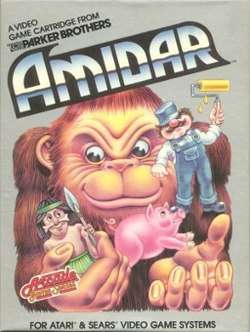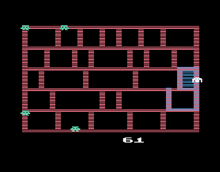Amidar
- For the Israeli government-operated housing firm, see Amidar
| Amidar | |
|---|---|
 North American cover | |
| Developer(s) | Konami |
| Publisher(s) | Stern, Olympia (North America) |
| Platform(s) |
Arcade (original) Atari 2600, Casio PV-1000 |
| Release |
Arcade
|
| Genre(s) | Maze |
| Mode(s) | Up to 2 players, alternating turns |
| Cabinet | Upright |
| CPU | Z80 (@ 3.072 MHz) |
| Sound |
Sound CPU: Z80 (@ 1.78975 MHz) Sound chips: (2x) AY8910 (@ 1.78975 MHz) |
| Display | Raster, 224 x 256 pixels (Vertical), 106 colors |
Amidar is an arcade game programmed by Konami and published in 1981 by Stern. Its basic format is similar to that of Pac-Man: the player moves around a fixed rectilinear lattice, attempting to visit each location on the board while avoiding the enemies. When each spot has been visited, the player moves to the next level.
The game and its name have their roots in the Japanese lot drawing game Amidakuji. The bonus level in Amidar is a nearly exact replication of an Amidakuji game and the way the enemies move conform to the Amidakuji rules - this is referred to in the attract sequence as 'Amidar movement'.
Gameplay

As in Pac-Man, the player is opposed by enemies who kill on contact.[1] The enemies gradually increase in number as the player advances from one level to the next, and their speed also increases. On odd-numbered levels, the player controls an ape (in some versions labeled "Copier"), and must collect coconuts while avoiding headhunters (labeled "Police" and "Thief"). On even-numbered levels, the player controls a paint roller (labeled "Rustler"), and must paint over each spot of the board while avoiding pigs (labeled "Cattle" and "Thief"). Each level is followed by a short bonus stage.
Whenever a rectangular portion of the board is cleared (either by collecting all surrounding coconuts, or painting all surrounding edges), the rectangle is colored in, and in the even levels, bonus points are awarded (In odd-numbered levels, the player collects points for each coconut eaten). When the player clears all four corners of the board, he is briefly empowered to kill the enemies by touching them (just as when Pac-Man uses a "power pill"). Enemies killed in this way fall to the bottom of the screen and revitalise themselves after a few moments.
The game controls consist of a joystick and a single button labeled "Jump," which can be used up to three times, resetting after a level is cleared or the player loses a life. Pressing the jump button does not cause the player to jump, but causes all the enemies to jump, enabling the player to walk under them.
Enemy movement
The enemies (and bonus stage pigs) in Amidar move deterministically; this is described in the game as "Amidar movement". Each normal-type enemy moves vertically from the top to the bottom of the screen, and then back to the top, and so on. While moving in a constant vertical direction, the enemy will take every horizontal turn available until they reach the top or bottom of the grid, when they will continue to move either left or right in the direction they are headed and then take the first vertical turn available to re-enter the game board. This ensures that, while the movement of the enemies can be predicted and avoided, there are no safe points on the grid in which the player can stay still for too long. Each level has one special enemy (the "Tracer", colored white) which, at the beginning of each stage, simply patrols around the perimeter of the gameboard in an anti-clockwise direction. However, following a certain number of "laps", The Tracer will begin to relentlessly pursue the player by following the path their on-screen avatar takes. While the Tracer cannot deviate from following the player's exact route, it does not mimic any pauses the player makes, meaning that hesitations or backtracking will eventually allow the Tracer to catch up and kill the player. Later levels increase difficulty by adding more complex game grids, adding more enemies, and reducing the delay before the Tracer begins pursuit, until eventually it gives chase after a single lap at the beginning of each stage.
Level differences
In the even-numbered levels where the player controls a paint roller, the roller cannot move too far from grid rectangles that have already been filled without running out of paint and having to return to completed parts of the map to refresh its supply. When this happens, any painted lines which are not part of a filled rectangle will vanish and must be painted again. In practical terms, this means that the player must build their completed squares around the starting point of the level (which always has a fresh supply of paint) and spread outwards, rather than completing squares in any part of the game board they please, as they can on the odd-numbered levels. This also makes filling the corner rectangles and becoming invincible more difficult.
Ports and clones

Amidar was published for the Atari 2600 in 1982[1] and the Casio PV-1000 console in 1983. Gakken released a handheld version of Amidar in 1982. It was one of a series of three flip-top games with VFD screen and magnifying Fresnel lens.
The Amidar concept was highly cloned for 1980s arcade games, consoles and home computers. See the Grid capture games section of the List of maze video games.
Competition
There are two known ROM sets for Amidar, a harder version distributed by Stern and an easier set created by Konami. According to Twin Galaxies, Scott Karasek, of Racine, Wisconsin, USA, scored a world record 3,208,870 points on the Stern ROM set on June 22, 1982. On the Konami ROM set, Todd Lamb reached 19,225,030 points in Kenosha, Wisconsin, USA, on October 1, 1983.
References
- 1 2 Fox, Matt (2013). The Video Games Guide: 1,000+ Arcade, Console and Computer Games, 1962-2012. McFarland. p. 11. ISBN 9781476600673.
External links
- Amidar at the Killer List of Videogames
- Amidar at the Arcade History database